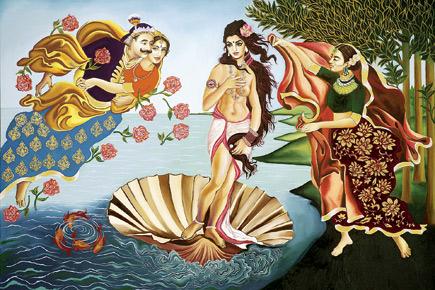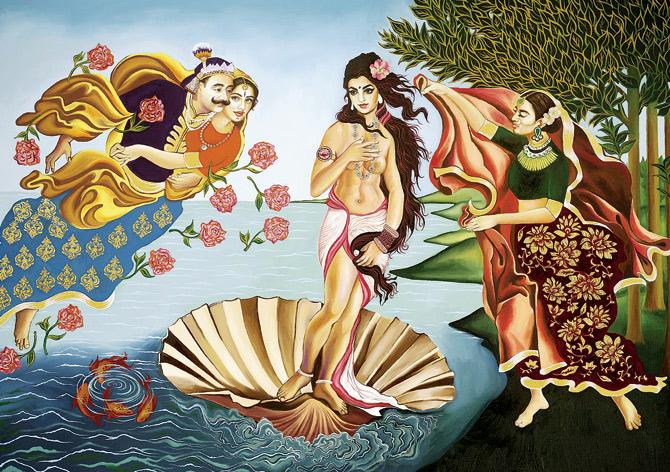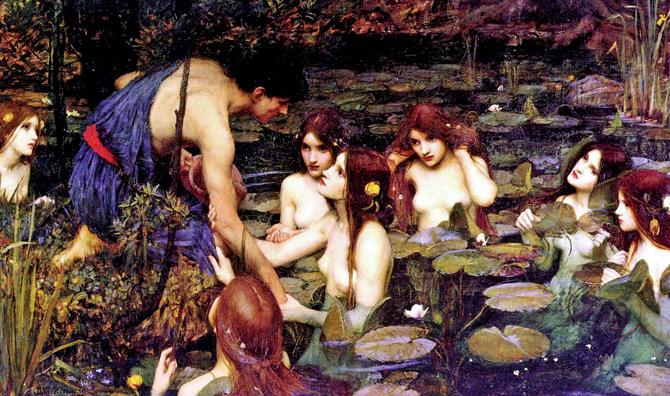It seems like a Botticelli, but it isn’t. In Neha Kapil’s "re-mixed" version of the hugely popular The Birth of Venus — painted in the 15th century by the Florentine, Sandro Botticelli — the composition is remarkably similar, except for an overhaul of the featured characters

Birth of Satyavati by Neha Kapil, which re-imagines Botticelliu00c3u00a2u00c2u0080u00c2u0099s famous painting
ADVERTISEMENT
It seems like a Botticelli, but it isn’t. In Neha Kapil’s "re-mixed" version of the hugely popular The Birth of Venus — painted in the 15th century by the Florentine, Sandro Botticelli — the composition is remarkably similar, except for an overhaul of the featured characters. In Kapil’s painting, instead of Venus sailing placidly, we have a curvaceous woman, wispily clad in a lal paar saree, and decked with jewels and flowers. Kapil’s heroine is a village belle, rather than the sublime Roman goddess of love. Please say hello to Satyavati — the woman who smelled like fish — from the Mahabharata.

Birth of Satyavati by Neha Kapil, which re-imagines Botticelli’s famous painting
Titled Birth of Satyavati, this painting is part of Kapil’s ongoing series of "desi remixes". "I was lucky enough to get to see the original The Birth of Venus a few years ago while studying in Italy. Since then, it’s been one of my favourite paintings, not because it’s such a recognizable painting in popular culture, but because it represents a lot of traditional beauty standards in the Western world," says Kapil, 22. Based in Minneapolis, USA, this visual artist adds, "If Caucasians could ‘borrow’ aspects of our culture, I thought it would be interesting to practise reverse cultural appropriation on recognisable Western paintings. This is how I got the idea of Indianising The Birth of Venus."

Hylas and the Nymphs (1896) by John William Waterhouse
Kapil started these desi remixes soon after she graduated from the University of Michigan, where she studied art, design and psychology. Other completed works in this series include Urvashi and Visha Kanyas. Urvashi pays homage to the eponymous apsara and King Pururavas. ‘Urvashi was returning from her task of breaking the rishi Vibhandaka’s penance, when she was abducted by a demon. Pururavas [chased] the demon away, freeing Urvashi. The brief moment they touched changed their lives forever,’ writes Kapil on her website (www. nehakapilart.com). For Urvashi, Kapil took up Michelangelo’s The Creation of Adam. Here, the lovestruck king holds on lightly to the tassel of Urvashi’s girdle.

Visha Kanyas, Kapil’s “desi remix” of Waterhouse’s painting
"I chose works by celebrated European artists because I’ve always appreciated classical art and realism. Growing up, I took art lessons from a woman trained in classical realism and an expert on the works of the old masters. Being around her, my love for the classics only grew," says Kapil. While The Creation of Adam and The Birth of Venus have been borrowed by popular culture repeatedly (remember Lady Gaga’s ArtPop album cover or the poster for Spielberg’s E.T.?), Kapil appropriates a relatively lesser known work by John Williams Waterhouse, titled Hylas and the Nymphs, in which a young lad is abducted by water nymphs. Visha Kanyas, as Kapil calls her painting, shows a prince falling for the charms of young women, who in fact are assassins trained to overthrow opponents with their powers of seduction. Legend has it that these dangerous beauties had poison running in their veins, rather than blood.

"I wanted the figures in my versions to correspond to examples of strong women who aren’t commonly celebrated in mythology. Indian mythology’s stories are about men fighting epic battles, so I wanted to create something about "her-story". Moreover, Western art traditionally has always celebrated sexuality and the human body; however, as Indians, we tend to shy away from the topic of sexuality," says Kapil, adding that she loves Hindu mythology for its current relevance. "Western mythology is just stories. Indians grow up hearing these stories — they are part of our festivals and still very much alive in our culture."
Kapil, who has also visualised Bollywood pop culture, first researches European art for pieces that show interactions between men and women. Next, she researches Indian story books "to find examples of clothing, lifestyle, jewellery and other accessories — all of which come together in desi remixes, which use acrylic and oil paint. While Kapil’s men and women may not have the same detailing as Botticelli’s, they have the flavour of Raja Ravi Verma’s vivid pop lithographs.
The desi remix series, Kapil’s way of engaging with her Indian roots, is currently available only online. While the artist has not decided whether she will exhibit these works or not, she tells us that a future work in this series might be inspired by Gustav Klimt. Perhaps The Kiss, with Draupadi smooching her five husbands?
 Subscribe today by clicking the link and stay updated with the latest news!" Click here!
Subscribe today by clicking the link and stay updated with the latest news!" Click here!







